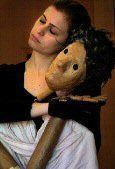Le Livre Blanc, attributed to Jean Cocteau, was originally published anonymously in 1928 and only partly acknowledged in the preface to the publication of its English translation with "Who wrote it? Did I? Probably . I'd not be in the least ashamed of it." In it Cocteau, if indeed it is he, describes a number of homosexual (and attempts at heterosexual) relationships which, though in the form of a novella, may have an autobiographical element and include Dargelos, a character who appears is other Cocteau works. Director Poppy Burton-Morgan has taken one strand from these stories and adapted it for performance with music by Ed Hughes.
It is presented as a monologue spoken by the first-person authorial character with the action that he describes performed by puppets representing the speaker and his lover, with shadow theatre appearances of the woman who makes a triangle of their relationship.
Some references in Le Livre Blanc, including those to Mlle R and a lover living in Versailles, overlap with references in another Cocteau text, La Voix Humaine, and this has led director Poppy Burton-Morgan to present this as a companion piece to the music drama by Poulenc to that Cocteau text. It runs on continuously in her production.
This linked double bill is presented on a stage littered with boxes and roles of cable. On either side is an upright piano, the strings on view. They are being played and gradually the music resolves into a series of repetitive phrases being played on one piano alone while the other player is still. Is this just a piano? No, it might be an old fashioned telephone exchange as well. The pianist appears to unplugging cable to disconnect and reconnect callers as he plays the notes. Two women wind up some of the cable. We see there is a telephone on a lidded box, and a mound of red ribbon spilling around it.
This goes on for nearly ten minutes after time for curtain up: it is an important part of the show in preparing the audience for the minimalist mood of what is to follow. The suggestion of a telephone operator immediately suggest the context of the Poulenc work but, when the houselights go down and the previously silent pianist begins to play, it is the other piano player who turns, with a heavily shadowed, almost clownish makeup to become the author narrator of Le Livre Blanc. Will Reynolds speaks it strongly and movingly, sometimes interacting with the puppeteers, easily overcoming the drawback, when I saw it, of a slightly raspy throat.
At first, at least, I found the puppets most effective. They present only a face and head with one skeletal wooden arm and hand extending from below a cloth-draped coathanger but initially make the audience ignore the performer and concentrate only on the lover's faces. There were occasions later when this focus faltered, when alignments between human and puppet or the angle between puppet face and audience interfered and turned them back into heads on sticks. Understandably, perhaps, there is no attempt to represent their bodies; in a story of physical as well as romantic love that might have become banal. However the designers choice of draping cloth over the coat-hanger gave quite the wrong suggestion. On first exposure to the first puppet I assumed it represented the speaker's mother, some much like an aging female were the hairstyle and the shawl-like fabric. Perhaps the intention was to suggest the feminine in the protagonist's nature but to me it was a mistake. These are young men, not drag queens. You only have to look at Cocteau's drawings to see the kind of men he has in mind. Nevertheless, the performance is effective. It made me want to see a further exploration of this novella as a theatre text.
Without a break the performance elides into that of the Poulenc setting, played here by Benedict Lewis-Smith in a one piano version of the score. It is quite beautifully sung by Rebecca Lea (who also appears as the shadow singer in the first part of the bill). A solo piece which is extremely demanding on the performer with three-quarters of an hour of high emotion she had no recourse to obvious histrionics but maintained an intensity of feeling that held the audience.
Director Burton-Morgan does not confine her to a couch or chair beside a telephone, nor does she update things with a mobile handset which would make the references to someone on the party line or conversations with the telephone operator anachronistic. Instead she has the inspired idea of paralleling those cables which were being coiled up at the beginning of the performance with the red ribbon on the stage which becomes an ever lengthening cable, also linking telephone to hand-piece, that unravels like her life, allowing her to wander about the expanses of the playing space, and even among the audience, leaving a trail of bright colour patterning the stage.
When the script requires her to twine the cable about her neck, she does so, a red slash across her throat as well as a reminder of strangulation, but this staging resists presenting a suicide ending as has sometimes been suggested and in her dejection the singer also manages to suggest some form of resolution in the final moments.
The run at Riverside has ended but the production will be appearing at the Avignon Festival in July - the exact venue is still to be announced.

